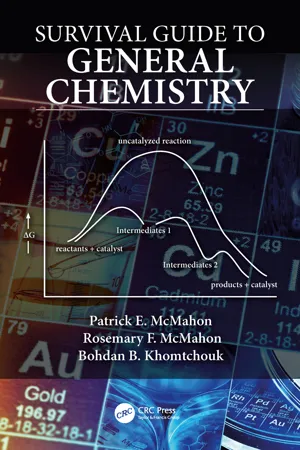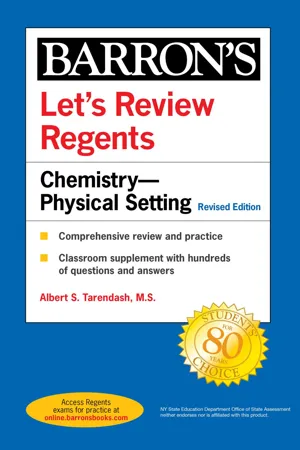Chemistry
Naming Ionic Compounds
Naming Ionic Compounds involves identifying the cation and anion present in the compound and naming them accordingly. The cation is named first, followed by the anion with the suffix "-ide" added to the end of its name. Roman numerals are used to indicate the charge of the cation if it is a transition metal.
Written by Perlego with AI-assistance
Related key terms
Related key terms
1 of 4
Related key terms
1 of 3
5 Key excerpts on "Naming Ionic Compounds"
- eBook - ePub
Chemistry
The Molecular Nature of Matter
- Neil D. Jespersen, Alison Hyslop(Authors)
- 2018(Publication Date)
- Wiley(Publisher)
Metal cations take the English name of the element, and when more than one positive ion can be formed by the metal, the Stock system is used to identify the amount of positive charge on the cation. This is done by placing a Roman numeral equal to the positive charge in parentheses following the name of the metal. Simple monatomic anions are formed by nonmetals, and their names are formed by adding the suffix - ide to the stem of the nonmetal’s name. Only two common polyatomic anions (cyanide and hydroxide) end in the suffix - ide. Understand the difference between ionic and molecular compounds Molecules are electrically neutral particles consisting of two or more atoms. Molecules are held together by chemical bonds that arise from the sharing of electrons between atoms. The formulas we write for molecules are molecular formulas. Molecular compounds are formed when nonmetals combine with each other. The simple nonmetal hydrides have formulas that can be remembered by the position of the nonmetal in the periodic table. Organic compounds are hydrocarbons, or compounds considered to be derived from hydrocarbons by replacing H atoms with other atoms. We found that it is often possible to distinguish ionic compounds from molecular compounds by their ability to conduct electricity. Molecular compounds are generally poor electrical conductors, whereas ionic compounds when melted into the liquid state or dissolved in water will conduct electricity readily. Name molecular compounds The system of nomenclature for binary molecular inorganic compounds uses a set of Greek prefixes to specify the numbers of atoms of each kind in the formula of the compound. The first element in the formula is specified by its English name; the second element takes the suffix - ide, which is added to the stem of the English name. For simple nonmetal hydrogen compounds, it is not necessary to specify the number of hydrogens in the formula - eBook - ePub
- Patrick E. McMahon, Rosemary McMahon, Bohdan Khomtchouk(Authors)
- 2019(Publication Date)
- CRC Press(Publisher)
not found in covalent compounds; however, the “ide” ending form of the last element is identical to the ion form of the name used for binary ionic compounds.(3) The combining ratio of elements in the covalent compound is identified by the use of prefixes to indicate the number of atoms of each element in the formula:mono- = 1di- = 2tri- = 3tetra- = 4penta- = 5hexa- = 6hepta- = 7octa- = 8a) To complete the name, start with the partial name based on steps (1) and (2), then add the appropriate prefix to each element that matches the number of each element listed in the formula.b) Exception: If the first element in the formula has the number 1, do not use the prefix mono-; absence of a prefix for the first element automatically indicates that the number of atoms in the formula is equal to 1.c) Exception: The last vowel on a prefix name (excluding di- or tri-) is dropped (for pronunciation) if the element name that it is attached to also begins with a vowel.d) Exception (sometimes optional): All prefixes for compounds containing the element hydrogen can be dropped; (often either name is acceptable).Examples: Name the nitrogen/oxygen molecules: N2 O; NO; NO2 ; N2 O4 ; N2 O5N2 O(1) Nitrogen(2) ( )nitrogen ( )oxide(3) N2 = dinitrogen O1 = monoxide; note that since oxide begins with a vowel, the last “o” on mono is dropped. Name: dinitrogen monoxideNO(1) Nitrogen(2) ( )nitrogen ( )oxide(3) N1 = nitrogen; note that if the first element in the name has the number “1,” the prefix mono is dropped O1 = monoxide; the prefix mono (with the last “o” dropped) is required for the second element in the formula. Name: nitrogen monoxideNO2(1) Nitrogen(2) ( )nitrogen ( )oxide(3) N1 = nitrogen O2 = dioxide; note that the last “i” on the prefix di cannot be dropped. Name: nitrogen dioxideN2 O4(1) Nitrogen(2) ( )nitrogen ( )oxide(3) N2 = dinitrogen O4 = tetroxide; note that the last “a” of tetra is dropped. Name: dinitrogen tetroxideN2 O5(1) Nitrogen(2) ( )nitrogen ( )oxide(3) - Albert S. Tarendash(Author)
- 2021(Publication Date)
- Barrons Educational Services(Publisher)
Chemistry.Try It Yourself
Write the formulas for the following compounds:- copper(II) sulfide
- iron(III) bromide
- tin(IV) oxide
- aluminum nitride
Answers
- CuS
- FeBr3
- SnO2
- AlN
Try It Yourself
Name the following compounds:- MgF2
- KH
- NiI3
- V2 O5
Answers
- magnesium fluoride
- potassium hydride
- nickel(III) iodide
- vanadium(V) oxide
Naming Compounds that Contain Polyatomic Ions
Ionic compounds that contain polyatomic ions are named in the same fashion as binary ionic compounds. The trick is to recognize that a polyatomic ion is actually present in the formula. At this point, you should review the names and formulas of the polyatomic ions contained in Reference Table E in Appendix 1.Problem
Name the following compounds:- K2 SO4
- NH4 NO3
- Fe(C2 H3 O2 )3
Solutions
- Note that two K+ ions are needed to balance the SO4 2– ion for charge. The name of this compound is potassium sulfate.
- This compound contains two polyatomic ions: NH+ and NO3 – . The name of this compound is ammonium nitrate.
- This compound contains the Fe3+ ion and the C2 H3 O2 – ion. The name of this compound is iron(III) acetate.
Try It Yourself
Name the following compounds:- Na3 PO4
- Hg(OH)2
- (NH4 )2 SO3
Answers
- sodium phosphate
- mercury(II) hydroxide
- ammonium sulfite
Writing Formulas for Molecular Compounds
Atoms in molecular compounds do not have real charges (as ions do in ionic compounds). Nevertheless, atoms are electrical in nature, and they can behave as though they possessed charges, even in molecular compounds. The type of charge found in molecular compounds is known as an apparent charge. To be able to work with both real and apparent charges, the concept of oxidation numbers (also known as oxidation states- Albert S. Tarendash(Author)
- 2021(Publication Date)
- Barrons Educational Services(Publisher)
Chapter ThreeFormulas, equations, and chemical reactions
Key Ideas
This chapter introduces the language of chemistry: formulas and equations. A chemical formula provides information about the atomic composition of a substance, while an equation allows us to describe a chemical reaction using the names or formulas of the reactants and products involved in the process.KEY OBJECTIVES
At the conclusion of this chapter you will be able to:- Distinguish between ionic compounds and molecular compounds.
- Define the following terms: ionic formula, molecular formula, empirical formula, structural formula, and binary compound.
- Write the formulas for ionic compounds containing simple and/or polyatomic ions and name these compounds using the IUPAC system.
- Define the term oxidation number (state) and assign oxidation numbers to elements, simple ions, and the elements contained in compounds and polyatomic ions.
- Write the formulas for molecular compounds and name these compounds using the IUPAC system.
- Write chemical equations using names and chemical formulas.
- Balance chemical equations.
- Classify a chemical reaction as synthesis, decomposition, single replacement, or double replacement.
Passage contains an image
Section I—Basic (Regents-Level) Material
NYS Regents Concepts and Skills
Note: By the time you have finished this chapter, you should have mastered the concepts and skills listed below. The Regents chemistry examination will test your knowledge of these items and your ability to apply them.Concepts are the basic ideas that form the body of the Regents chemistry course (what you need to know!).Skills are the activities that demonstrate your mastery of these concepts (how you show that you know them!).Following each concept or skill is a page reference (given in parentheses) to this chapter.3.1 Concept: A chemical compound can be represented by a specific chemical formula and assigned a name based on the IUPAC system. (Pages 57 , 59–64 - eBook - ePub
Chemical Graph Theory
Introduction and Fundamentals
- D Bonchev(Author)
- 2018(Publication Date)
- Routledge(Publisher)
CA indexes), although direct online access to chemical structures is now expanding rapidly. The terminology used in such indexes must reflect general usage and must be at least reasonably familiar to chemists searching the indexes. In the past, trivial names were used extensively for this reason, but more recently it has become less practical to do so and use of trivial names has declined in favor of more systematic names.3.2 Development of Chemical NomenclatureThe origins of chemical nomenclature can be traced back to ancient China and Egypt [11 , 12 , 13 , 14 ]. Since then, chemical nomenclature has developed in a cyclical fashion, with existing practices being adequate for a time, then becoming progressively more inadequate until a crisis develops, and then the cycle being completed by introduction of a novel system that, in turn, proves adequate for a time.It is not the function of this chapter to trace the development of chemical nomenclature in detail; this has already been done by Crosland in a very readable book [11 ], where references to the literature can be found. But it is useful to highlight here some important historical developments.The first development of importance was the proposal of the first systematic nomenclature, principally for inorganic compounds, in 1787. This proposal introduced such names as sodium sulfate and potassium hydrogen tartrate, despite the lack of a supporting theory.The first step in the development of a supporting theory was the introduction, by Dalton in 1803, of symbols representing single atoms rather than any amount of an element. This led to the first attempts to represent chemical structures by structure diagrams (Figure 3
Index pages curate the most relevant extracts from our library of academic textbooks. They’ve been created using an in-house natural language model (NLM), each adding context and meaning to key research topics.
Explore more topic indexes
Explore more topic indexes
1 of 6
Explore more topic indexes
1 of 4




